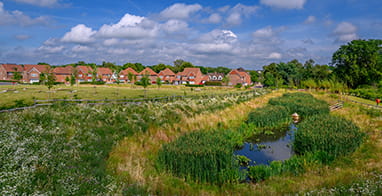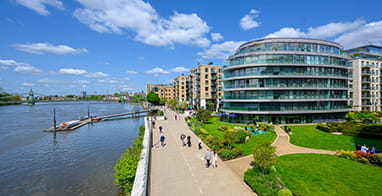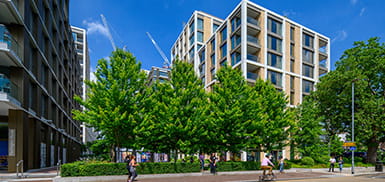Environmental, Social and Governance (ESG) Overview
A Purposeful and Responsible Business
We have always been driven by a clear purpose - to build quality homes, strengthen communities and improve people's lives.
Building on these foundations, in 2010 we created a long-term strategy to guide our business and we called it Our Vision. Our vision is to be a world-class business, trusted to transform the most challenging sites into exceptional places and to maximise our positive impact on society, the economy and the natural world. In 2021 we launched Our Vision 2030; the Berkeley Group's ambitious responsible business strategy for the future which sets out our roadmap to 2030 across 10 strategic priorities. Read more about Our Vision 2030 here.
The Berkeley Group has a number of policies that cover key ESG-related issues and our business operations. Our policies can be found here.
We are pleased that our approach to ESG through the delivery of Our Vision has been recognised externally, including as part of our achievement of being named Britain’s Most Admired Company for 2024. Our company’s commitment and transparent communication of progress against key ESG topics led to Berkeley’s inclusion in S&P Global’s Sustainability Yearbook 2024, receiving a top 10% Corporate Sustainability Assessment score and being the highest performing UK housebuilder.


Our Performance and Disclosure
Our latest performance on ESG topics is detailed within our Annual Report which can be found here. This includes climate-related disclosures in line with the recommendations of the Task Force on Climate-related Financial Disclosures (TCFD) and IFRS S2 Climate-related Disclosures. A summary of performance against our ESG indicators is also provided with more detail available below.
Additional disclosures, such as our GHG emissions and energy consumption reporting criteria, our CDP questionnaire responses and our Taskforce on Nature-related Financial Disclosures (TNFD) overview can be found here.
We also respond to a number of investor benchmarks assessing our performance.
| Benchmarks and Indices | 2024/25 | 2023/24 | 2022/23 | 2021/22 | 2020/21 | Notes | |
|
CDP Climate Change questionnaire rating
|
 |
B | A | A- | A- | A |
Berkeley Group was awarded a place on CDP’s Supplier Engagement ‘A List’ in 2024/25.
|
|
FTSE4Good Index Series listed company
|
 |
Y | Y | Y | Y | Y |
Berkeley has been featured on the Index since 2003.
|
| ISS ESG Corporate Rating |  |
B- | B- | B- | C+ | C+ |
Awarded ‘Prime’ status for fulfilling sector requirements regarding sustainability performance. The highest score achieved by our industry in 2024/25 is ‘B-’. |
|
MSCI ESG rating
|
 |
AAA | AAA | AAA | AAA | AAA |
We have achieved an AAA rating for the past nine years.
|
| S&P Global Corporate Sustainability Assessment |  |
69 | 56 | 53 | 47 | - | Score is out of 100. In 2024/25, Berkeley achieved a top 10% score and was the highest performing UK housebuilder. |
| Sustainalytics ESG Risk Rating | 12.8 (Low) | 14.0 (Low) | 14.1 (Low) | - | - | Smaller values indicate lower risk. |
A Sustainable Business
Our Vision 2030 includes three key sustainability topics as strategic priorities for the business; Communities, Climate Action and Nature. This is supported by our sustainability standards for our project teams and detailed management system to maintain high standards. Read more about our approach to sustainability here.
We are proud to have been one of the first 350 companies worldwide to set science-based targets (SBTs) for greenhouse gas (GHG) emissions reduction which align to a 1.5°C pathway and have been validated by the Science Based Targets initiative (SBTi). Read more here.
Read our Sustainability Report to find out more about our approach, progress, and achievements from 1 May 2024 to 30 April 2025.
Sustainable Development Goals
Berkeley Group is committed to helping to achieve the United Nations' Sustainable Development Goals (SDGs).
We have identified six of the goals as being most relevant to us, based on a review of our business activities and value chain against the goals and their underlying targets. We consider that we have the greatest opportunity to contribute to the achievement of these six goals, particularly through the implementation of the Our Vision 2030 responsible business strategy.







